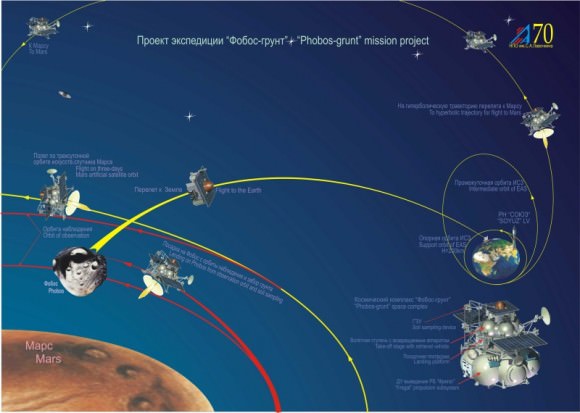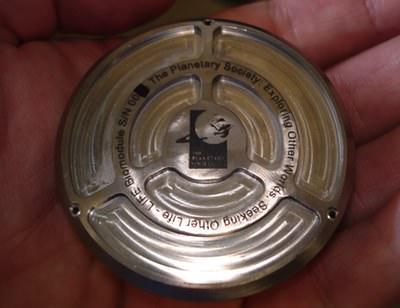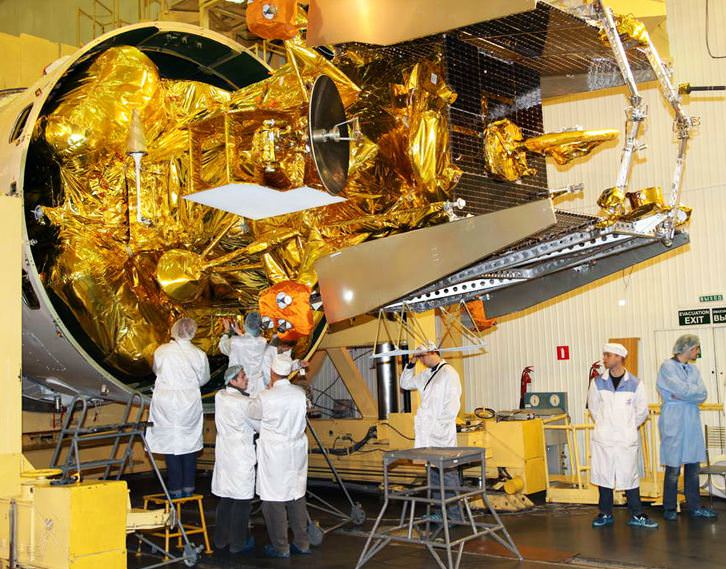[/caption]
According to a news report in RiaNovosti, Russia’s Phobos-Grunt spacecraft will fall January 14th, “somewhere between 30.7 degrees north and 62.3 degrees east,” placing debris near the city of Mirabad, in southwestern Afghanistan. RiaNovosti said this prediction is according to the United States Strategic Command who calculated the craft will reenter Earth’s atmosphere at 2:22 am.
Editor’s Update: In a call to USSTRATCOM to verify this information, a spokesperson said, “We are not making any statement at USSTRACOM at this time because we are not the lead for this event and cannot make an official statement for any predictions or what is releasable at this time.”
“Please note that the U.S. Strategic Command prediction had a large uncertainty associated with it, i.e., 11 days,” Nicholas L. Johnson, NASA’s Chief Scientist for Orbital Debris told Universe Today in an email. “No one is yet able to predict with confidence the day the Phobos-Grunt will reenter.”
If the probe is predicted to fall on land, this raises the possibility of recovering the Planetary Society’s Living Interplanetary Flight Experiment (LIFE), designed to investigate how life forms could spread between neighboring planets.

Carrying about 50 kilograms of scientific equipment, the unpiloted Phobos-Grunt probe was launched November 9th on a mission to the larger of Mars two small moons. Although the Zenit 2 rocket that launched the craft functioned flawlessly, sending Grunt into a low Earth orbit, the upper stage booster, known as Fregat, failed to boost the orbit and send it on a trajectory toward Mars. Thought to have reverted to safe mode, Phobos-Grunt has been flying straight and periodically adjusting her orbit using small thruster engines. While this maneuvering has extended the amount of time that the probe could remain in space before reentering Earth’s atmosphere, ground controllers have been struggling to establish a communication link.
For a while, space commentators considered the possibility that Grunt might be sent on an alternate mission to Earth’s Moon or an asteroid, if control could be restored after the window for a launch to Mars and Phobos was lost. During the past few weeks, the European Space Agency (ESA) started and ended efforts to communicate with the spacecraft on several occasions, but succeeded only twice. Various scenarios were imagined in which aspects of the probe’s mission could be salvaged, despite the serious malfunction that prevented the craft from leaving Earth orbit. But at this point, the only direction for the spacecraft to go is down.
In addition to equipment for making celestial and geophysical measurements and for conduct mineralogical and chemical analysis of the Phobosian regolith (crushed rock and dust), Grunt carries Yinhou-1, a Chinese probe that was to orbit Mars for two years. After releasing Yinhou-1 into Mars orbit and landing on Phobos, Grunt would have launched a return capsule, carrying a 200 gram sample of regolith back to Earth. Also traveling within the return capsule is the Planetary Society’s Living Interplanetary Flight Experiment (LIFE).

Specifically, LIFE is designed to study the effects of the interplanetary environment on various organisms during a long duration flight in space beyond the Van Allen Radiation Belts, which protect organisms in low Earth orbit from some of the most powerful components of space radiation. Although the spacecraft has not traveled outside of the belts, the organisms contained within the LIFE biomodule will have been in space for more than two months when the probe reenters the atmosphere.
The many tons of toxic fuel are expected to explode high in the atmosphere. However, since the return capsule is designed to survive the heat of reentry and make a survivable trajectory to the ground, it is quite possible that it will reach Afghanistan in one piece. Because the LIFE biomodule is designed to withstand an impact force of 4,000 Gs, it is possible that the experiment can be recovered and the biological samples studied.
To be sure, the possibility of recovering an unharmed returned capsule and LIFE depends on the willingness of the inhabitants around the landing site to allow the Russian Space Agency to pick it up. Given the proximity of the predicted landing area to a war zone and the fact that the Taliban are not known for being enthusiastic about space exploration and astrobiology, it is also possible that a landing on land could turn out no better than a landing over the deepest part of the ocean.
Source: RiaNovosti


Let’s hope it crashes on some talibans
Wait a minute. How can they be so precise this time? When the other two satellites came crashing down in October we didn’t know until the last second (and also afterwards) when or where it will come down.
And now they give the correct time and area where it will come down a month ahead? That seems highly unlikely to me. This would be only possible, if they could guide it down with its own thrusters – but then, they wouldn’t crash it onto Afghanistan, would they?
The correct prediction is decay on january 13, 2012 at 22h28 ± 264 hours, but the news are less glamorous with the uncertainty.
The correct prediction is decay on january 13, 2012 at 22h28 ± 264 hours, but the news are less glamorous with the uncertainty.
maybe we didnt know because the other two satellites were old technology’s..
Yeah, let’s bombard Afghanistan. :DDD
Yeah, let’s bombard Afghanistan. :DDD
I suppose the RIA Novosti prediction is a joke. Either Russians have devised this rumor themselves or somebody has told them for a fun.